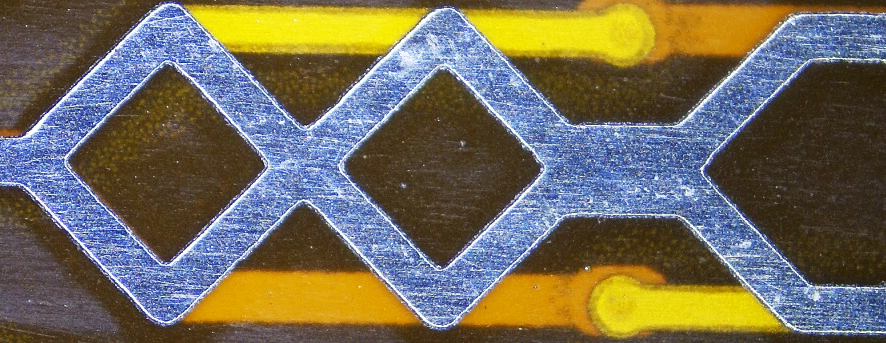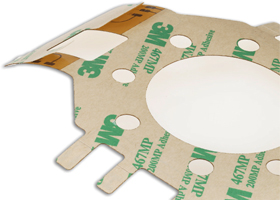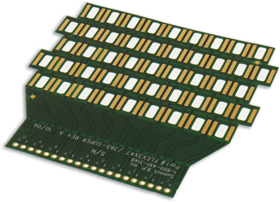
High delivery rate, sample delivery rate of 99.59%, 12 hour express delivery, nationwide free shipping, small batch delivery takes 1-2 days.
Choose high-quality raw materials, strictly control the manufacturing process and implement standardized quality management to create high-quality products.
Provide professional technical support with fast response and real-time feedback, and offer professional consulting advice based on customer needs.
Product category:
Type number: 01Y04C00269A
Number of layers: 1
Plate thickness: 0.15mm
Material: double-sided non-adhesive electrolytic material
Copper thickness: 1/2 OZ
Special point: Extra long 2.5M
Surface treatment: Gold 2 micro inches
Minimum line width/line distance: 0.07mm/0.06mm
The single-layer flexible circuit is the most basic, consisting of a flexible polyimide film laminated onto a thin copper sheet. The copper layer is then chemically etched to produce a circuit pattern that meets your specific design requirements. A polyimide coating is then added to insulate the circuit and protect the environment.
A double-sided flexible circuit is a single-sided flexible circuit manufactured in such a way that conductive materials can be contacted from both sides of the circuit. The flexible circuit is the frontrunner in this technology, which uses specialized laser and processing techniques to peel away the polyimide layer of the substrate, thereby achieving double contact with a single copper layer.
A two-sided flexible circuit is a circuit with two conductive layers, one conductive layer on each side of the polyimide base layer in the circuit. A trace pattern can be created on both sides of the substrate film according to your needs and can be connected using copper-plated through holes where needed. Copper plated through holes create an electrical connection between the two layers.
Multilayer flexible PCB circuit
Multiple single-sided or double-sided circuits are combined with complex interconnect, shielding, and/or surface mount technologies to form multi-layer designs. Multiple layers may or may not be continuously laminated together throughout the production process. If your design requires maximum flexibility, continuous laminating may not be appropriate. Multilayer circuits are an effective solution when faced with the following design challenges: inevitable crossover, specific impedance requirements, crosstalk elimination, additional shielding, and high component density.
When leveraging multi-layer flexible circuits to help you design solutions, flexible circuits can proudly say "we go where no one else can."
Soft and hard board
It has been used in the military and aerospace industries for more than 40 years. In rigidly bonded boards, layers of flexible and rigid materials are used to create rigid and flexible areas in a single package.
Stiff-flex bonding circuits integrate the advantages of rigid plates and flexible circuits into one circuit.
The rigid outer layer is connected to the inner flexible layer using copper-plated through holes. Rigid flexible circuits provide higher component density and better quality control. A rigid design is used where additional support for SMT components is required, and a flexible design is used where bending and bending are required to fit into tight Spaces.
The single-layer flexible circuit is the most basic, consisting of a flexible polyimide film laminated onto a thin copper sheet. The copper layer is then chemically etched to produce a circuit pattern that meets your specific design requirements. A polyimide coating is then added to insulate the circuit and protect the environment.
A double-sided flexible circuit is a single-sided flexible circuit manufactured in such a way that conductive materials can be contacted from both sides of the circuit. The flexible circuit is the frontrunner in this technology, which uses specialized laser and processing techniques to peel away the polyimide layer of the substrate, thereby achieving double contact with a single copper layer.
A two-sided flexible circuit is a circuit with two conductive layers, one conductive layer on each side of the polyimide base layer in the circuit. A trace pattern can be created on both sides of the substrate film according to your needs and can be connected using copper-plated through holes where needed. Copper plated through holes create an electrical connection between the two layers.
Multilayer flexible PCB circuit
Multiple single-sided or double-sided circuits are combined with complex interconnect, shielding, and/or surface mount technologies to form multi-layer designs. Multiple layers may or may not be continuously laminated together throughout the production process. If your design requires maximum flexibility, continuous laminating may not be appropriate. Multilayer circuits are an effective solution when faced with the following design challenges: inevitable crossover, specific impedance requirements, crosstalk elimination, additional shielding, and high component density.
When leveraging multi-layer flexible circuits to help you design solutions, flexible circuits can proudly say "we go where no one else can."
Soft and hard board
It has been used in the military and aerospace industries for more than 40 years. In rigidly bonded boards, layers of flexible and rigid materials are used to create rigid and flexible areas in a single package.
Stiff-flex bonding circuits integrate the advantages of rigid plates and flexible circuits into one circuit.
The rigid outer layer is connected to the inner flexible layer using copper-plated through holes. Rigid flexible circuits provide higher component density and better quality control. A rigid design is used where additional support for SMT components is required, and a flexible design is used where bending and bending are required to fit into tight Spaces.
Static application - The flexible circuit is bent only to mount the circuit and install it into the application (also known as flexible mounting or flexible mounting). Static applications usually use less expensive electrolytic (ED) copper.
Dynamic bending applications - Situations in which the flexible circuit itself is dynamically (repeatedly) bent during the actual use of the end product. Common examples include clamshell phones, laptops, printer heads, and robotic arms. Dynamic applications require the use of rolled (RA) copper.
Flexible circuits with SMT and assembly
The benefits of flexible circuits are realized in most applications that require a lot of bending and/or high precision. Some common applications include:
· Airbag system
· Automobile engine control
· Anti-lock brake
· Avionics
· Bar code equipment
· Battery pack
· Computer
· Camera
· Mobile phone
· Heart monitor and pacemaker
· Fuel pump
· Hearing aid
· Printer
· Motor system
· GPS system
· Satellite
In short, if you have flexible circuit design or flexible printed circuit board needs, we can help.

304 stainless steel
Conductor - Copper is the most widely used conductor and comes in a variety of thicknesses to meet each customer's requirements. Conductor options include:
· Rolled Copper (RA)
· Electrolytic copper (ED)
· Aluminum
· Carbon
· Silver paste
· Stainless Steel ®
· Constantan

Double sided flexographic laminated adhesive
Adhesives - The choice of adhesives depends on customer requirements and conductor thickness. Common adhesives include:
· Epoxy resin
· Acrylic fiber
· Pressure Sensitive Adhesive (PSA)
· No adhesive (substrate)

Dual layer flexible circuit board with flexible solder shield
Insulators - Flexible substrates (substrates) and cladding materials are available in a variety of thicknesses and are supplied by several manufacturers. Common insulators include:
· Polyimide
· Polyester, polyethylene naphthalate (PEN) and polyethylene terephthalate (PET)
· Solder resistance layer
· Flexible solder resistance layer
· Imageable Covering Film (PIC)
· Screen printing dielectric
3 layers flexible.5 oz copper selective lead bonding Ni/Au assembly and radiator bonding
Surface treatment - The final surface treatment depends on each customer's assembly requirements and the application of the finished product. Common surface treatments include:
· Solder (tin, lead or RoHS compliant)
· Tin
· Nickel/gold sinking
· Hard nickel/gold
· Lead key alloy
Organic: entek or organic solderability Protectant (OSP)
· Silver
· Carbon
In short, if you have flexible circuit design or flexible printed circuit board needs, we can help.
with Flexible components for LED and aluminum heat sinks
Radiators - Radiators can be laminated onto flexible circuits to dissipate heat from sensitive components such as leds.
Two-layer flexible module
Component Assembly - We offer through-hole and surface mount capabilities, as well as circuit testing, conformal coating and electrostatic protection packaging.
Double-layer flexible cable with controllable impedance
Controlled impedance - As signal switching speeds increase, engineers need to understand and control the impedance of the wires. Due to the short signal conversion time and high clock frequency of modern digital circuits, the wiring needs to be treated as a transmission line rather than a simple interconnection. With today's increased speed requirements, controlled impedance wiring is designed to minimize electrical reflection and ensure error-free conversion between tracks and interconnects. When perfectly optimized, the controlled impedance can control the physical size and material of the cable. Controlled impedance signal transmission requires uniform thickness and electrical properties of flexible circuit materials. At Flexible Circuit Technologies, we have extensive experience in designing and manufacturing flexible circuits with controlled impedance.
Single layer flexible crimp weld UHB adhesive antenna
Crimp pin - The crimp pin mechanically joins the circuit to achieve a welded connection.
Double layer flexible plate with pattern overlay switch
Graphic overlay - The graphic overlay can be placed on a flexible circuit, rigid plate or film switch. The overlay provides the underlying circuitry for the user interface and is usually used in conjunction with leds, LCD displays, or dome switches mounted on these circuits. The covering is made of polycarbonate, polyester or acrylic material.
Single side 0.5 oz copper laser cut with slot
Laser cutting slots and holes - In the past, people used X-acto knives or blades to cut complex areas of flexible circuits, with success depending on the skill of the operator. FCT greatly improves this process by using a top-of-the-line laser beam with extremely precise depth control to precisely cut the underlying substrate of the flexible circuit. Precise laser beams can cut circuit openings with extreme precision.
Double layer flexible circuit board with cladding molding and wire connection.
Encapsulation molding - Encapsulation molding is the process of embedding an FCT into an electronic component, rather than simply placing the electronic component on a circuit. As electronic devices and the required interconnections become more compact, embedding electronic circuits into cable assemblies is a cost-effective alternative to on-board electronic components. These embedded devices, often referred to as smart cables or dongles, can solve many packaging challenges.
Panel component assembly
Pressure sensitive adhesive (PSA) - PSA with release film is used in applications where a part of the circuit needs to be secured to a specific location within the end product. During assembly, the detached film is stripped, exposing the adhesive that allows the assembler to press the circuit into place and hold it there.
Single layer carved flexible plate
Carved flexible circuits - Carved flexible circuits are special in that the copper conductors vary in depth and thickness at different locations. The copper in the most flexible part of the circuit is thinner and the copper at the interconnect point is thicker. Sculpted flexible circuits allow bare metal connections (such as plug-ins) and remain strong while solder joints are formed. Carved fingers provide a more reliable alternative to mechanically fixed crimping pins.
Double layer flexibility with rigid component assembly area
Stiffener - Stiffener is suitable for flexible circuits that require additional support, such as component assembly areas or bare lines for connection. Common reinforcing tendons are FR4 and polyimide.
Flexible circuit with harness
Wire assembly - In some applications, a combination of flexible or rigid circuits with conventional wires may be a more economical design while still meeting customer component needs. At Flexible Circuit Technologies, we have the ability to design, procure, manufacture and assemble entire components, including circuits, wires and components. This capability and commitment sets us apart from other flexible circuit suppliers. That's why our motto is "We go where others won't".
Flexible heater
Flexible heaters - Flexible heaters are thin, flexible heating elements that are shaped to meet your unique heating equipment needs.
The flexible circuit is connected to the rigid plate by hot pressing welding
Hot pressure welding - Hot pressure welding is a method of eliminating the set of connectors between hard plates and flexible circuits. This connection provides an efficient, durable, and less expensive alternative to standard connector sets.
Laser cutting single-sided circuit to achieve dual access
In short, if you have flexible circuit design or flexible printed circuit board needs, we can help.